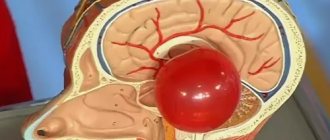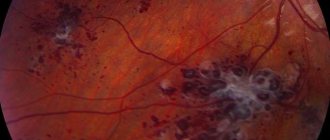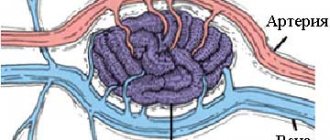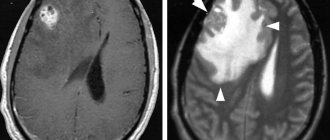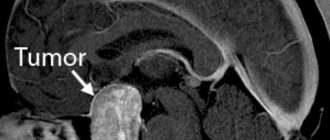Brain sarcoma is a malignant oncological disease that develops from poorly differentiated connective tissue cells. The neoplasm penetrates into neighboring tissues and organs and is a metastatic form of cancer. Brain sarcoma is diagnosed in only 2% of patients. The disease can manifest at any age. The danger is that the tumor is detected in late stages, when even surgery does not help.
What types of brain tumors are there?
Based on the primary site of occurrence , brain tumors are divided into:
- A primary brain tumor is one that arises directly from brain cells, its membranes, or cranial nerves.
- A secondary brain tumor is one that formed in some other organ (for example, the lung) and metastasized through the bloodstream to the brain.
According to histological properties , they are usually named according to the type of cell from which they develop:
- Neuroepithelial tumors – from the brain epithelium (astrocytoma, glioma);
- Meningeal - from the cells of the membranes of the brain (meningioma);
- Tumors of the cranial nerves – neuromas;
- Dysembryogenetic tumors develop due to disruption of the development of the neural tube in the prenatal period.
Are there any features of brain tumors?
Brain tumors are truly special, and the reason for this is the so-called blood-brain barrier (BBB).
The BBB is a physiological barrier between our blood and the cells of the nervous system. It is he who regulates the flow of various substances from our bloodstream into the cerebrospinal fluid and nervous tissue. This barrier protects our brain from microorganisms, toxins and, of course, cancer cells formed in other organs and metastasized to the brain. But it is the BBB that becomes an obstacle in the treatment of primary tumors, since it does not “let through” not only toxins, but also drugs.
Another characteristic of brain tumors is that sometimes benign tumors are as difficult to treat as malignant ones, depending on their size and location in the brain.
In addition, their peculiarity lies in the distribution by stages (more on this below, in the section “Brain cancer, stages” )
What are the causes of brain cancer?
Let’s not say anything new; the exact cause of brain cancer, like cancer of other organs, is not fully known. But with all types of cancer, there is a change in the most important macromolecule for humanity - DNA.
DNA is the macromolecule that makes up our genes. Namely, genes control the work of our cells - when to divide and when it is time for them to die.
A tumor is a collection of atypical (“bad”) cells that quickly divide and do not perform any functions.
There are two types of genes in the human body:
- Oncogenes - their activation “stimulates” cells to quickly divide and, as a result, a tumor forms.
- Tumor suppressor genes/antioncogenes are genes that, on the contrary, control cell proliferation, preventing them from dividing randomly.
Cancer occurs when oncogenes turn on and anti-oncogenes turn off.
According to epidemiological and experimental studies, there are several factors that play a significant role in the occurrence of brain tumors:
- Genetic - that is, if a parent has a DNA “breakage” with antioncogenes, then there is a risk of transmitting this DNA to the child;
- Environmental factors, in particular aromatic bicarbonates;
- Viruses;
- Radioactive agents;
- Biological – puberty or aging.
Causes and risk factors
The reasons for the development of sarcoma, like most other oncological pathologies, have not yet been fully studied. However, there are a number of factors that significantly increase the risk of its development. In most cases, the decisive circumstances are:
- serious injuries to bones or soft tissues, resulting in irreversible changes in connective structures;
- the presence of a family history of malignant pathologies; hereditary factors play a significant role;
- organ transplant operations performed;
- the formation of benign formations in which malignant processes develop over time;
- precancerous diseases;
- exposure to radiation or chemical compounds on the body, previous chemotherapy and radiotherapy;
- infection with oncogenic viruses (hepatitis B, human papillomavirus, etc.);
- the presence of foreign bodies in the tissues;
- advanced chronic pathologies (for example, chronic osteomyelitis, osteitis deformans, etc.);
- too rapid growth of the body during puberty (for example, bone tissue damage is often diagnosed in adolescents who are significantly taller than their peers).
It is important to consider that the presence of one or even several of the listed factors does not necessarily lead to the development of an oncological process. In many cases, the origin of sarcoma is explained not by direct, but only by indirect reasons: smoking, living in environmentally polluted areas, working in the chemical industry, malfunctioning of the body's immune forces, and other sources: Soft tissue sarcomas. Fedenko A.A., Gorbunova V.A. Moscow, RF: RONTs im. N.N. Blokhin RAMS; 2012, p. 23-34.
Brain cancer, stages
As mentioned earlier, one of the peculiarities of these tumors is that they are not divided into stages according to the generally accepted TNM system.
- T (tumor – tumor) – in the case of brain cancer, its size is not as important as its location and what it comes from;
- N (nodus – lymph node) – there are no lymphatic vessels in the brain;
- M (metastasis - metastases) - occur slowly and rarely.
Therefore, they are divided according to the WHO classification proposed in 2007 into four degrees of anaplasia. It is based on a combination of histological, genetic and patient survival data and includes four stages:
- Brain cancer, stage 1 – this includes neoplasms with low proliferative activity (divide slowly), they are treated surgically.
- Brain cancer, stage 2 – tumors are infiltrative in nature (grow into nearby tissues), have a low ability of cells to divide, and often recur.
- Brain cancer, stage 3 - the tumor grows quickly, spreads to nearby tissue, and the tumor cells are very different from normal cells.
- Brain cancer, stage 4 - defined as cytologically malignant, almost always recurs, has an unfavorable prognosis, and widely grows into adjacent brain tissue.
Main characteristic symptoms
Symptoms of fibrosarcoma depend on various factors: location, presence of metastases, size, prevalence, history. Fibrosarcoma can develop both inside the body and superficially. In the second option, it is easy to recognize the disease already in the first stages of development, and a course of treatment or surgical intervention is selected for the patient. In the first case, the tumor may not manifest itself at all; symptoms may appear in the later stages. Treatment of fibrosarcoma in this case will be difficult. The patient may be worried about other diseases, and as a result of the examination, fibrosarcoma will be diagnosed. Often patients turn to the doctor only when the tumor creates discomfort, which means it has already reached a significant size. As the tumor increases in size, nerve fibers are compressed, which causes pain. In the first stages, the skin retains its natural shade; if subcutaneous fatty tissue is depleted, the skin acquires a bluish tint, and the vessels will be clearly visible from under the depleted tissue.
The main characteristic symptoms of fibrosarcoma include:
- in the first stages the disease does not manifest itself and does not bother you in any way;
- the focus of the disease begins to develop from the soft tissues;
- a single tumor often passes without metastases and develops slowly;
- The patient experiences pain in the area of the tumor.
To determine fibrosarcoma, doctors prescribe a number of tests and studies. If a histological examination reveals white-gray tissue, this is a sign of the development of fibrosarcoma. If the disease has reached late stages of development, metastases appear in the lungs and lymph nodes.
What are the symptoms of brain cancer?
Common signs of brain cancer. Any tumor formed in the brain puts pressure on the brain tissue, which causes increased intracranial pressure and contributes to the occurrence of the following symptoms:
- Headache, often of a bursting nature;
- Nausea, vomiting, which provides temporary relief;
- Double vision;
- Dizziness;
- Impaired consciousness;
- Hemiparesis (paralysis of the arm and leg on one side);
- Cramps.
Focal symptoms of brain cancer, depending on location:
- Ataxia (impaired coordination) in the limbs, tremor, nystagmus towards the affected side (cerebellar tumors)
- Violation of statics, muscle hypotonicity (tumors of the cerebellar vermis)
- Hearing impairment, motor coordination, paresis of facial muscles (tumors of the cerebellopontine angle)
- Swallowing disorders, tongue deviations, sensitivity disorders of the pharynx, face (trunk tumors)
Let's look at the symptoms of several common tumors:
Glioblastoma, signs (IV stage) . Glioblastoma is a malignant brain tumor that arises from astrocytes (the supporting cells of the nervous system). Clinical symptoms progress quickly, after 2-4 months general and focal symptoms are mixed, epileptic seizures and psychopathological personality changes are observed.
Sarcoma of the brain , formed from the connective tissue of the brain. Symptoms of brain sarcoma are similar to those of other brain tumors and may include:
- Headache;
- Nausea;
- Impaired consciousness;
- Mental changes;
- Convulsions; Speech disturbances.
Pituitary adenoma - most often develops from the anterior lobe of the pituitary gland and is characterized by hormonal disorders that lead to the following symptoms:
- Hypersecretion of adrenocorticotropic hormone - high blood pressure, increased blood glucose levels, stretch marks on the hips, amenorrhea in women, impotence in men, osteoporosis, increased male pattern hair growth.
- Hypersecretion of prolactin – amenorrhea in women, milk secretion in women, infertility in men.
- Hypersecretion of somatotropic hormone - an increase in the size of the limbs and tongue, increased sweating.
Establishing a diagnosis
Diagnosis of brain sarcomas begins with an examination by an oncologist, who records external oncological signs, that is, the appearance of:
- jaundice on mucocutaneous tissue;
- pale skin color;
- bluish tint of lips;
- swelling in the face and neck;
- increased fulness of veins on the surface of the head;
- severe exhaustion.
Intoxication of the body with sarcoma provokes:
- increased body temperature;
- the appearance of general weakness;
- excessive sweating at night;
- decreased desire to eat.
Instrumental diagnostics of brain sarcomas is carried out. Explore:
- lumbar (spinal) puncture to detect blood elements and atypical cells of different sizes and shapes;
- biopsy - to detect small cells with one large or two small nucleoli, to determine the structure of the cytoplasm. With sarcoma, it will be homogeneous and granular;
- CT scan - to establish the boundaries of tumor formation, outlines, signs of growth in the brain, metastases in the lungs and bone tissue.
One type of brain sarcoma can be confirmed by laboratory tests if:
- networks of thin-walled capillaries;
- atypical cancer cells in the form of bundles directed in different directions;
- cells that have a thin shell and large nuclei after a pathological change;
- acute deficiency of healthy cells in the tissue or their complete absence;
- excess intercellular substance with many hyaline and cartilaginous elements of connective tissue.
Read here: What is breast, mammary gland, breast cancer?
As a result of a cytogenetic study, abnormalities of the chromosomes of oncological cells are revealed. When testing blood:
- it is impossible to identify the type of formation due to the lack of specific tumor markers;
- a general analysis reveals the concentration of hemoglobin, red blood cells, leukocytes, platelets and ESR;
- biochemical analysis reveals the percentage of lactate dehydrogenase. At high concentrations (over 250 U/l), the disease will be aggressive.
An x-ray of the sternum may reveal metastasis to soft and bone tissue. A mediastinal tumor may appear round or irregular in shape. Its body varies in size from 1 mm to 10 cm and larger, with a heterogeneous structure.
How are brain tumors diagnosed?
- Neurological examinations help determine whether the tumor is affecting brain function.
- Magnetic resonance imaging (MRI) is the most common method of imaging almost any brain tumor. MRI signals differ depending on the water, calcium, and fat content of the tumor. The nature of the signal is influenced by the cystic component of the tumor and hemorrhage into the tumor.
- Computed tomography (CT) scan – allows visualization of abnormalities or tumors in the brain. The method can help detect bleeding and enlarged fluid-filled spaces in the brain. In addition, computed tomography allows you to see changes in the bones of the skull. CT can also be used to measure the size of a tumor and in cases where the patient does not have access to an MRI, for example, if a person has a pacemaker for the heart.
- Positron emission tomography (PET) or PET-CT scan - a small amount of radioactive substance is injected into the patient's body. This substance is absorbed by actively dividing cells. Because tumor cells are more likely to actively divide, they absorb more radioactive material. The scanner then detects the substance and creates images.
- A lumbar puncture is a procedure in which a needle is used to remove a sample of cerebrospinal fluid to look for tumor cells, blood, or tumor markers.
- Biopsy + histology. A biopsy is the removal of a small amount of tissue for examination under a microscope. This is the only definitive way to diagnose a brain tumor.
Treatment
Achieving complete recovery and regression of malignant cancer is possible only with complex treatment, which includes surgery, radiation therapy and chemotherapy drugs.
The surgical method involves excision of the tumor. A complex operation involves craniotomy. Unfortunately, it is impossible to achieve complete removal of the sarcoma, since it does not have clear outlines and literally fuses with the surrounding tissues. Additional chemotherapy and radiation help achieve remission and prevent relapse. Chemicals and radiotherapy are designed to completely destroy cancer cells. They are carried out both before and after surgery: in the first case, this treatment tactic helps to reduce the primary tumor.
If it is impossible to perform an operation (a difficult-to-reach place, a large area of damage, a serious condition of the patient who may not be able to withstand general anesthesia), radiation oncology is resorted to. Radiation therapy includes a course consisting of several sessions. After radiation therapy, patients experience headaches, vomiting and nausea.
Hypofractionated stereotactic radiation therapy is used to treat inoperable tumors. Special equipment performs an accurate calculation of the direction and power of ionizing radiation and creates a thin beam of radiation. This selectivity allows you to preserve healthy tissue.
Chemotherapy drugs destroy actively dividing cells. The main disadvantage of chemotherapy is the serious side effects. The patient’s immunity weakens, intoxication develops, and the epithelium of the gastrointestinal tract, hair follicles, and even bone marrow cells involved in hematopoiesis are affected. Patients complain of nausea, vomiting, stool disorders, hair loss and weakness. There is a decrease in the number of leukocytes and a deficiency of hemoglobin.
Is there a cure for brain cancer?
Treatment for a brain tumor is usually complex and may include surgery, chemotherapy, radiation and drug therapy.
Main methods of treatment:
Surgery - a small hole is made in the skull and the tumor is removed;
Radiation therapy - this method uses high-energy radiation from an external or internal source to destroy cancer cells, most often after surgery and in conjunction with chemotherapy. Radiation therapy can slow down the division or stop the growth of malignant cells;
Radiosurgery is an approach to radiation therapy that uses many tiny beams of radiation to target a tumor to kill it. Most often it is used if it is impossible to perform an operation;
Chemotherapy - Chemotherapy drugs are used to kill cancer cells after surgery or to relieve symptoms, or in cases where the tumor cannot be removed;
Carmustine implants are a new way of delivering chemotherapy for certain high-grade tumors where implants are implanted in the brain. Carmustine belongs to a class of drugs called alkylating agents. It works by slowing or stopping the growth of cancer cells in the body.
Prevention
Preventive measures help prevent the development of the disease. Under no circumstances should you expose your body to radiation even for therapeutic purposes.
Do not forget about routine magnetic resonance imaging and computed tomography, which can detect sarcoma in the early stages. Preventive measures include:
- Keeping a diary in which the duration, time of onset and intensity of headaches are noted, if they become bothersome. This information will help the neurologist.
- Following an anti-cancer diet, which includes a large amount of fresh vegetables and the absence of carcinogenic foods (bacon, smoked fish, salted meat).
- Giving up bad habits, maintaining a healthy lifestyle, getting a full eight hours of sleep, no stress, regular rest.
Brain cancer, prognosis
Survival from brain cancer depends on many factors, and only by studying the patient’s medical history can a doctor form a prognosis. To give an overall picture, below are statistics* on five-year survival rates for patients with brain cancer:
- The 5-year survival rate for people with brain cancer or a central nervous system tumor is almost 36%, and the 10-year survival rate is almost 31%.
- Survival rates decline with age.
- The 5-year survival rate for people under 15 years of age is more than 74%.
- For people aged 15 to 39 years, the 5-year survival rate is about 71%.
- The 5-year survival rate for people age 40 and older is about 21%.
But still, you shouldn’t focus on “dry” statistics; everything happens differently for each of us. Therefore, before drawing any conclusions, consult your doctor on this issue.
*-Statistics adapted from the American Cancer Society, Cancer Facts & Figures 2021, ACS website (January 2021)
Where and how can I buy Israeli medicines?
- In an Israeli pharmacy - after examination by a specialist. If you undergo diagnostics at the Ichilov Oncology Center, you will receive an individual sarcoma treatment protocol and prescriptions for drugs. By purchasing them in Israel, you can be treated at home.
- In any locality in the world where the patient lives. The Ichilov Cancer Center offers foreign patients to use the telemedicine program and undergo examination by an Israeli doctor remotely. During the consultation, you will also receive an individual treatment protocol and prescriptions for medications. After this, you will be able to order medications delivered to your home.
